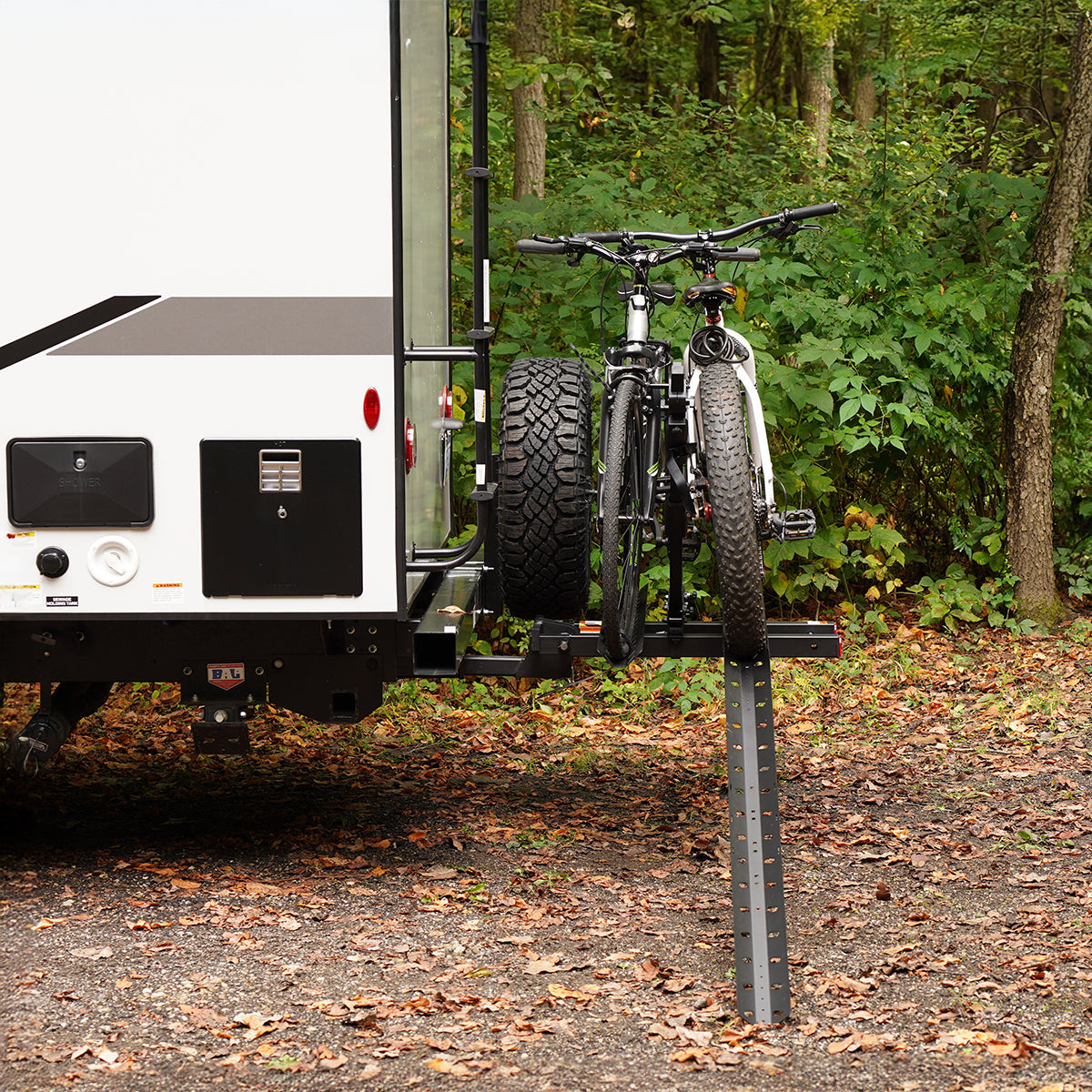
Van life and road trips are even better when you can bring your bicycles along for the adventure. Whether you drive a MB Sprinter camper, a Ford Transit conversion, a Ram Pro Master, a classic VW Bus, or a trusty Ford Econoline, choosing the right bike rack for campervan travel is key. In this guide, we’ll compare the main types of campervan bike carriers—hitch, ladder, roof, and platform styles—offer setup tips, and highlight our top product picks. By the end, you’ll know how to find the best bike rack for campervan adventures based on your van’s size and your cycling needs.

What to Consider Before Choosing a Bike Rack for Your Campervan
Before you buy, take a few important factors into account:
- Weight Limits & Hitch Capacity: Always check how much weight your hitch and vehicle can support. Overloading the hitch’s tongue weight rating is dangerous. If you own a Ford Transit, Sprinter, or ProMaster, consult your owner’s manual for towing and carrying specs. For more details on how Transit vans handle different capacities, see our blog on campervan weight limits and towing specs. When in doubt, go by the lowest-rated component—vehicle, hitch, or rack.
- Rear Door Clearance: Many campervans have rear double doors that swing wide. A fixed rack could block those doors completely. Some racks tilt, swing away, or slide out to allow access. If you rely on rear storage often, a rack with clearance features will save you from unloading bikes every time you need to open the doors.
- Vehicle Size & Height: High-roof vans like Sprinters or Transits make roof racks impractical. Lifting a bike 9 feet overhead or up a ladder isn’t easy. Smaller vans, like VW campers or Econolines, are more roof-rack-friendly but still require a lot of effort.
- Existing Features: Does your van have a rear ladder or mounted spare tire? A ladder rack could be a natural fit, but it will limit ladder use. If you carry a spare or already use your hitch for towing, you’ll need to plan around those factors.
Choosing wisely upfront ensures your rack works with your van’s dimensions, lifestyle, and storage needs.
Note: Unlike bike racks for travel trailers and 5th wheels, campervan bike racks don’t need to be “RV-approved.” If you’re towing or outfitting an RV, see our guide on RV-Approved racks to ensure safety and compliance.
Types of Bike Racks for Campervans
There’s no single solution for everyone. Here are the four main categories of campervan bike racks, with pros and cons for each.

Hitch-Mounted Bike Racks
Hitch racks are the most popular choice for Sprinters, Transits, and ProMasters. They attach directly to the hitch receiver for a secure hold.
- Capacity & Stability: Most can carry 2–4 bikes with ease, especially when mounted to a 2-inch Class III hitch. Smaller hitches can handle only light-duty racks.
- Ease of Loading: Bikes sit just a couple of feet off the ground, so loading is straightforward.
- Rear Access: Many tilt or swing away to allow rear doors to open. Premium racks even slide straight out for full clearance.
For more details on hitch-mounted carriers in general, see our Hitch Platform Carrier FAQs. If you’re worried about blocked doors, check out our guide to the slide-out and swing away carriers.

Ladder-Mounted Bike Racks
If your van has a rear ladder, you can attach a ladder-mounted rack. These are common on VW campers and some Class B motorhomes.
- Ideal For: One or two standard bikes.
- Pros: Lightweight, affordable, and easy to install.
- Cons: Limited capacity and not suitable for heavy e-bikes. You’ll also need to lift bikes higher to load.
Ladder racks keep your hitch free but aren’t designed for heavy-duty use.

Roof-Mounted Bike Racks
Roof racks can work on lower vans like Econolines or VW campers but are less practical on tall vans.
- Pros: Keep the rear of your van clear and usable.
- Cons: Hard to load, especially on tall vans. They increase vehicle height and reduce fuel economy.
- When to Use: Best for lightweight bikes and shorter vans where you can reach the roof safely.

Platform or Cargo Carrier Bike Racks
A hybrid option is using a hitch-mounted platform or cargo carrier with bike adapters. These carriers can haul bikes alongside gear like coolers or storage bins.
- Pros: Multi-use. Carry bikes and extra cargo together. Some enclosed carriers even protect bikes from weather and theft.
- Cons: Bulkier than a traditional rack and require careful weight distribution.
If you like the flexibility of hauling both gear and bikes, check out our Van Cargo Carrier Guide.

Van-Specific Rear Door Bike Racks
Another option for campervans is a van-specific door rack designed to fit the contour of the back doors. These racks are built for certain models like the Ram ProMaster, Sprinter, or Transit, and mount directly to the door with brackets or adhesive pads.
- Ideal For: Campervans without a hitch who want a clean, integrated way to carry two bikes.
- Pros: Purpose-built for specific van doors, often with a slim profile that keeps bikes close to the vehicle. They free up the hitch and roof for other uses and keep bikes at an easy loading height.
- Cons: Compatibility is limited to certain vans — not all models have a matching system available. Installation can involve adhesive or drilling, meaning it’s more permanent. Weight capacity is usually capped at two standard bikes, so heavy e-bikes aren’t recommended.
These rear door racks can be a tidy solution for vans like the ProMaster or VW campers, but their limited compatibility and semi-permanent install mean they’re best suited for owners who know they’ll stick with one van platform long-term.

A Quick Comparison of Bike Racks for Campervans
Here's the TLDR on bike racks options for your campervan.
| Rack Type | Capacity & E-Bike Compatibility | Ease of Loading | Best For | Trade-Offs |
|---|---|---|---|---|
| Hitch-Mounted | 2–4 bikes depending on hitch size; excellent for e-bikes on Class III 2" receivers | Easy — bikes sit low to the ground | Sprinter, Transit, ProMaster owners needing stable, high-capacity racks | Requires hitch; may block rear doors unless tilt, swing, or slide-out |
| Ladder-Mounted | 1–2 standard bikes; not rated for heavy e-bikes | Moderate — must lift bikes higher onto ladder | VW campers, Class B vans with ladders | Blocks ladder use; limited stability and capacity |
| Roof-Mounted | 1–2 lightweight bikes; not suitable for heavy e-bikes | Difficult — requires lifting overhead or using step stool | Lower vans like VW, Econoline, or pop-top campers | Adds vehicle height, reduces fuel economy, hard to access |
| Platform or Cargo Carrier | 2–4 bikes plus gear; many models support heavy e-bikes, trikes, and cargo bikes | Easy — often includes ramps for rolling bikes on | Van lifers who want to haul both bikes and gear | Bulkier; requires careful weight distribution |
| Van-Specific Rear Door | 2 standard bikes; generally not e-bike compatible | Easy — door-height loading | Vans like ProMaster, Transit, or Sprinter without a hitch | Limited compatibility; semi-permanent install with adhesive or drilling |

Best Bike Racks for Campervans (Our Top Picks)
Here are some of the top options from our Bicycle Carriers Collection, designed to fit a wide range of campervans.
 |
BikeWing-2 PRO – Compact 2-Bike Hitch RackLightweight yet durable, the BikeWing-2 PRO bike carrier transports two bikes up to 40 lbs each. Rubber cradles adjust to fit road, hybrid, or mountain bikes. A tilt feature allows rear door access even with bikes mounted, making it great for Eurovans or Campervans with swing-up hatches. |
 |
V-Lectric 3.0 – Slide-Out Hitch Rack for E-BikesSpecifically designed for heavy e-bikes, the V-Lectric 3.0 supports two bikes up to 60 lbs each. Its slide-out platform gives Sprinter and Transit camper van owners full access to rear doors without unloading. Locking features keep your bikes secure on the road. |
 |
V-Lectric VFR – Folding Ramp RackBuilt for the heaviest bikes, the VFR includes integrated ramps so you can roll bikes on instead of lifting. Each tray supports up to 80 lbs, perfect for fat-tire e-bikes or cargo bikes. It folds upright when not in use and slides out for rear access. |
 |
TriQuad – Carrier for Trikes & Quad CyclesFor recumbent trikes or four-wheel cycles, the TriQuad is purpose-built. Extra-long trays and dual ramps make loading easy. Rated for 80 lbs per bike, it can handle heavy e-trikes with stability. Like the others, it slides out for van door clearance. |

Campervan Bike Rack Installation Tips
Installing a rack correctly makes all the difference:
- Hitch Racks: Use anti-rattle devices like Silent Hitch Pin® to keep the rack steady. Check bolts and pins before each trip.
- Roof Racks: Position trays evenly, and secure both wheels and frame. A step stool can help load bikes safely.
- Rear Door Clearance: Test how far doors open with the rack attached. Slide-out or swing-away features work best for full access.
- Weight Distribution: Place heavier bikes closest to the vehicle. Balance loads evenly on roof racks and platforms.
- Security: Use built-in locks plus a secondary cable lock. Consider locking the rack itself to the hitch.
For more clearance strategies, see our article on slide-out and swing away carriers.

Campervan Bike Rack FAQs
Can I open my van doors with a hitch rack on?
Yes, if you choose a rack with tilt, swing, or slide-out features. Without these, you’ll likely need to remove bikes to open the doors.
How many bikes can a campervan carry?
Most racks hold 2–4 bikes. Ladder and roof racks are usually limited to 2. Hitch racks can go up to 4 or more, depending on hitch class and bike weight.
What’s the difference between 2-bike and 4-bike racks?
Two-bike racks are lighter and simpler. Four-bike racks are larger, require a 2-inch hitch, and may reduce stability if overloaded. Some modular racks expand from 2 to 4.

Can I carry electric bikes on campervans?
Yes—use a hitch-mounted e-bike-rated rack on a 2" Class III receiver for the best mix of capacity and stability. Most electric bicycles weigh 50–75 lbs each, so confirm per-bike limits on both your rack and hitch. Roof and ladder racks are generally not recommended for e-bikes due to weight and lifting height. Choose platforms with a slide-out base for rear-door access.
Is a hitch mandatory for all campervan bike racks?
No. Ladder and roof racks bypass the hitch entirely. However, a hitch gives you the widest range of stable, heavy-duty options.
Does carrying bikes affect fuel economy?
Yes, especially with roof racks, which create more drag. Rear-mounted racks have less impact but still add weight.

Choosing the Best Bike Rack for Your Campervan
The best bike rack for campervan life depends on your van type and how you travel. A family with a Transit might need a 4-bike hitch rack, while a solo VW camper owner might find a ladder rack perfect. If you carry heavy e-bikes, look at platform racks with slide-out bases. If storage flexibility is important, consider cargo carriers with bike adapters.
Every setup is different, but the good news is there’s a rack that fits your van and your lifestyle. Choose carefully, install securely, and you’ll enjoy countless cycling adventures from the road.
Explore the best bike racks for campervans in our Bicycle Carriers Collection.



